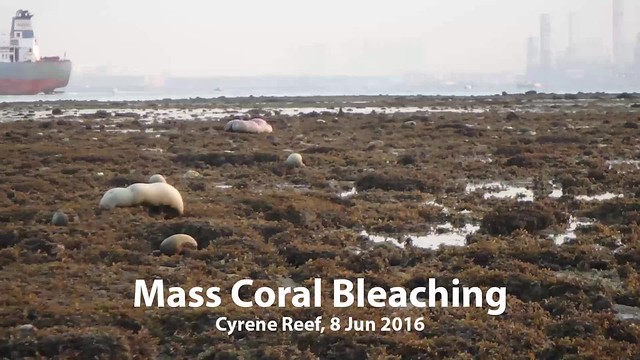About 80-90% of the hard corals and soft corals that I saw were bleaching.
Here's a video of the mass coral bleaching on one small part of the reef that I surveyed.
This was not unexpected. From the NOAA's coral reef watch satellite monitoring shows that Singapore is in the Watch zone. Where we should be prepared for mass coral bleaching.
What is coral bleaching?
Coral are colonies of tiny animals called polyps. Each polyp lives inside a little hard skeleton. The huge colony is made up of the skeletons of countless polyps.
The polyps of all reef-building hard corals harbour microscopic, single-celled algae (called zooxanthellae). The polyp provides the zooxanthellae with shelter and minerals. The zooxanthellae carry out photosynthesis inside the polyp and share the food produced with the polyp. Corals generally have white colour skeletons, which is believed to assist in photosynthensis by reflecting light onto the zooxanthellae.
When there is massive loss of zooxanthellae in a hard coral colony, the polyps become colourless and the underlying white skeleton shows through. Thus patches of the colony appear pale, white or 'bleached'. The polyps are still alive and the hard coral is not dead (yet).
Without the food provided by the lost zooxanthellae, the polyps will be stressed and prone to diseases. Skeleton production and reproduction are also affected. Once the cause of bleaching is removed, however, polyps may eventually regain zooxanthellae (which live freely in the water) and thus recover their health. But prolonged bleaching can kill corals and seriously damage large sections of a reef. Bleaching leathery soft corals and Asparagus flowery soft corals.
Factors believed to cause bleaching include: temperature fluctuations (too high or too low), excessive exposure to ultraviolet light, excessive sedimentation in the water, changes in salinity and disease. It is generally believed that bleaching is related to unusual prolonged temperature increases in the seawater. Hard corals harbouring zooxanthellae live close to the upper limit of temperature tolerance. Thus a temperature increase of even 1-2 degrees centigrade can redult in bleaching. It is believed that global warming will lead to massive bleaching. About 80% of the leathery soft corals that I saw were bleaching.
Not all the large coral colonies were bleaching. Some were still nice and brown.
Bleaching leathery soft corals with a hard coral that is just starting to bleaching.
A bleaching leathery soft coral next to a hard coral that is not bleaching.
Bleaching leathery soft corals next to one that is not.
All the Brain corals I saw were bleaching.
Most of Anemone corals and Small goniopora corals I saw were not bleaching, although some were oddly coloured. I only saw one bleaching Anemone coral colony.
All the Cauliflower corals I saw were bleaching. The one Sandpaper coral I saw was very yellow.
Most of the Boulder pore corals I saw were alright. About 20% had bleaching spots, and only a few were completely bleaching.
About 50% of the Flowery disk corals I saw were bleaching. The other half had odd colours, only a few were their usual colours.
Most of the other Disk corals I saw were alright with only a few that were yellowish.
Pebble corals I saw seemed alright. The Branching Montipora corals growing in the seagrasses were mostly alright, although smaller fragments were bleaching.
Among the Merulinid corals I saw, about 60% were completely bleached.
About 90% of the Asparagus flowery soft corals that I saw were completely bleached. And other flowery soft corals were also bleaching.
Animals that contain symbiotic algae also bleach. These include sea anemone. Most of the Haddon's carpet anemones I saw were not bleaching. But most of these were bleaching: Giant carpet anemones, Snaky anemones, Frilly anemones.
I saw some zoanthids bleaching too.
Despite the mass coral bleaching, life goes on in the reef. And we still saw fishes, crabs and other reef creatures going about their usual business. Like this Cheese cake nudibranch.
Cyrene is not just a reef. It also has vast seagrass meadows, probably among the best in Singapore. Knobbly sea stars remain abundant on Cyrene. Including small ones, which shows that the population on the reef is self sustaining.
Kok Sheng pointed out the Vermillion flatworms feeding on ascidians growing commonly in the seagrass meadows.
Also abundant today were White sea urchins, some were huddled together is large numbers. Common sea stars were also plentiful, many in 'mating position'.
I noticed that some of the seagrasses had 'burnt' leaves: leaf blades that were black.
There were still many Tape seagrasses that were cropped short, although I saw many clumps with long leaf blades.
Is this a dugong feeding trail on the seagrass meadows of Cyrene?! I was also glad that none of the team observed fish traps or nets on Cyrene today.
Cyrene lies in the middle of the industrial triangle made up of the massive industries on Jurong Island, huge refineries on Pulau Bukom and the world-class container terminals at Pasir Panjang. And yet it has rich marine life.

High res photos of mass coral bleaching in Singapore for free download on wildsingapore flickr
Posts by others on this trip
- Marcus Ng on facebook.
- Ian Siah on facebook.
- Richard Kuah on facebook.
- Loh Kok Sheng on his blog.
- Lisa Lim on facebook.
- Jonathan Tan on facebook.
Others on this trip: Nick Yap, Ivan Kwan, Koh Kwan Siong.































